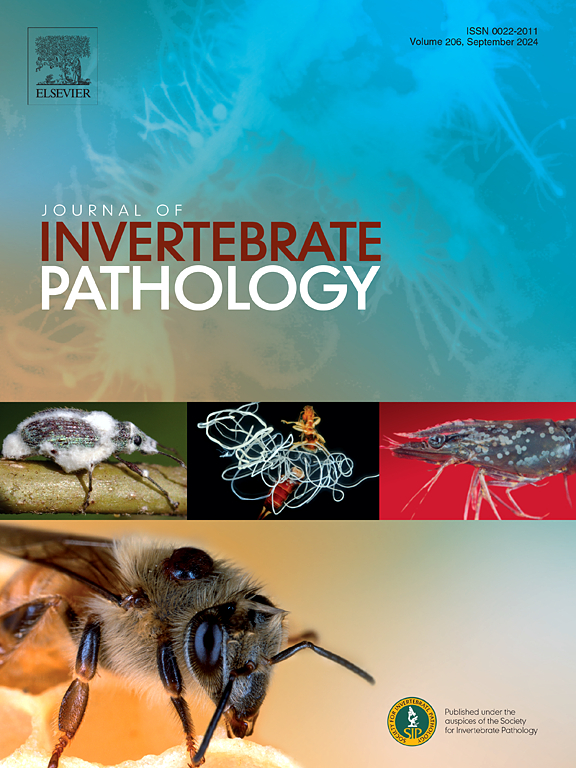黑兵蝇(Hermetia illucens)的多种双鞭毛虫毒素对细菌挑战的不同反应。
IF 3.6
3区 生物学
Q1 ZOOLOGY
引用次数: 0
摘要
由于具有巨大的生物转化潜力,黑兵蝇(Hermetia illucens)有望成为一种具有成本效益的生物废物循环利用替代品。BSF 幼虫(BSFL)经常接触大量病原微生物,包括细菌和真菌,这赋予了 BSFL 强大的免疫系统。双黄连是一种富含甘氨酸的抗菌肽(AMP),对革兰氏阴性细菌具有活性,它含有富脯氨酸结构域(P-domains)和富含甘氨酸结构域(G-domains);这些结构域之间有一个呋喃裂解位点。虽然 BSFL 双鞭毛虫毒素的存在和表达模式已被记录在案,但它们的基本分子特性仍不清楚。据我们所知,在本研究中,我们首次报告了七种全长 cDNA 序列的 H. illucens 双黄连蛋白的分子特征及其在革兰氏阳性或革兰氏阴性细菌挑战下的表达模式。7 个双鞭毛虫素同源物串联在 2 号染色体上,总长度为 38.6 kb,基因间的平均距离约为 5.5 kb。序列分析表明,由于过早终止密码子,三种双鞭毛虫蛋白(HipDptA/B/C)被假基因化。与此相反,其他双鞭毛虫毒素(HiDpt1/2/3/4)在 C 端具有成熟大小的富含甘氨酸的 G-结构域(这对 AMP 活性至关重要),在 N 端具有富含脯氨酸的结构域(P-结构域),在这些结构域之间有两个(HiDpt1/2/3)或一个(HiDpt4)假定的呋喃裂解位点(R-X-R/K-R)。这些呋喃裂解位点可能会产生一个富含甘氨酸的 AMP 和一到两个功能未知的附加肽。与其他双鞭毛虫毒素类似,HiDpt1/2/3/4 mRNA 的表达主要由革兰氏阴性细菌诱导,通常会增加≥ 1,000 倍(最高达 5,000 倍)。此外,HiDpt1/3/4 对革兰氏阳性细菌(如黄体微球菌)的反应也很明显,但不如对革兰氏阴性细菌的反应强烈。这些发现表明,HiDpts 是 BSFL 免疫系统中快速、有效和广谱的一线防御机制。本文章由计算机程序翻译,如有差异,请以英文原文为准。
Multiple diptericins of the black soldier fly (Hermetia illucens) differentially respond to bacterial challenges
Due to its significant bioconversion potential, the black soldier fly (BSF), Hermetia illucens, shows great promise as a cost-effective alternative for recycling biological waste. BSF larvae (BSFL) are constantly exposed high levels of pathogenic microorganisms, including bacteria and fungi, which endows BSFL with a robust immune system. Diptericin, a type of glycine-rich antimicrobial peptide (AMP) that exhibits activity against gram-negative bacteria, contains proline-rich domains (P-domains) and glycine-rich domains (G-domains); these domains are separated by a furin cleavage site. Although the presence and expression patterns of BSFL diptericins have been documented, their basic molecular properties remain unclear. To the best of our knowledge, in the present study, we report, for the first time, the molecular characteristics of seven full-length cDNA sequences of H. illucens diptericins and their expression patterns following challenges with gram-positive or gram-negative bacteria. Seven diptericin paralogs are located in tandem on chromosome 2, spanning a total length of 38.6 kb, with an average intergenic distance of approximately 5.5 kb. Sequence analysis revealed that three diptericins (HipDptA/B/C) are pseudogenized due to premature stop codons. In contrast, the other diptericins (HiDpt1/2/3/4) possess mature-sized G-domains rich in glycine at the C-terminus, which are essential for AMP activity, along with proline-rich domain (P-domain) in the N-terminal and either two (HiDpt1/2/3) or one (HiDpt4) putative furin cleavage sites (R-X-R/K-R) between these domains. These furin cleavage sites possibly produce a glycine-rich AMP and one or two additional peptides with unknown functions. Similar to other diptericins, the expression of HiDpt1/2/3/4 mRNAs is predominantly induced by gram-negative bacteria, increasing typically by ≥ 1,000-fold (up to 5,000-fold). Additionally, HiDpt1/3/4 show significant responses to gram-positive bacteria such as Micrococcus luteus, though not as strongly as to gram-negative bacteria. These findings suggest that HiDpts function as a rapid, effective, and broad-spectrum first-line defense mechanism in the BSFL immune system.
求助全文
通过发布文献求助,成功后即可免费获取论文全文。
去求助
来源期刊
CiteScore
6.10
自引率
5.90%
发文量
94
审稿时长
1 months
期刊介绍:
The Journal of Invertebrate Pathology presents original research articles and notes on the induction and pathogenesis of diseases of invertebrates, including the suppression of diseases in beneficial species, and the use of diseases in controlling undesirable species. In addition, the journal publishes the results of physiological, morphological, genetic, immunological and ecological studies as related to the etiologic agents of diseases of invertebrates.
The Journal of Invertebrate Pathology is the adopted journal of the Society for Invertebrate Pathology, and is available to SIP members at a special reduced price.

 求助内容:
求助内容: 应助结果提醒方式:
应助结果提醒方式:


